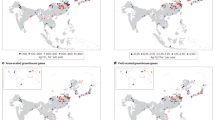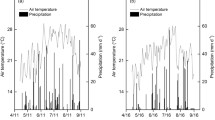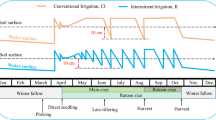Abstract
The System of Rice Intensification (SRI) is known as a climate-smart agricultural practice that increases rice production by changing the management of plants, soil, water, and nutrients. SRI water management relies on intermittent irrigation rather than on the continuous flooding of conventionally managed rice production. Different water table levels affect the soil conditions which contribute to different fluxes of greenhouse gas (GHG) emissions. This study estimated the impact on global warming potential (GWP) of GHG emissions from rice paddies when an SRI crop is managed with different water table levels. In this study, CO2 equivalence was assessed using a Simple Greenhouse Gas model, and an artificial neural network model for assessing CH4 and N2O. SRI paddy rice was grown in experimental pots under varying water table treatments, with the water table controlled by using Mariotte tubes set at + 2, 0, − 3, − 5, − 7, and − 12 cm from the soil surface. GHG emissions, which could be monitored more closely in pot trials than in fields, are a composite of the plants’ respiration, soil respiration (which is a result primarily of microbial activity), and the respiration that results from root exudates. With SRI practices, rice paddies can serve as a sink rather than a source for CH4 as seen from the negative values for CH4 emissions at all water table treatments. While there were N2O emissions with SRI practice, they were much less in terms of CO2 equivalence than the GWP reduction achieved by reducing CH4. Overall, under the experimental conditions the best water table level for SRI cultivation, with the most rice produced relative to GHG emissions, was − 5 cm from the soil surface. For each kg of grain produced, there were 0.80 kg CO2 eq of GHG emissions. By comparison, a normally flooded paddy field with usual crop management methods emits 1.97 kg CO2 eq per kg of grain produced, almost 150% more. This finding that a water table of − 5 cm is optimal will not necessarily apply for all field conditions, but the research addresses the desirability of seeking to optimize between GHG reductions and increased yield when growing paddy rice, and of developing appropriate methodology for achieving this composite objective.






Similar content being viewed by others
References
Barison J, Uphoff N (2011) Rice yield and its relation to root growth and nutrient-use efficiency under SRI and conventional cultivation: an evaluation in Madagascar. Paddy Water Environ 9:65–78. https://doi.org/10.1007/s10333-010-0229-z
BPS-Statistics Indonesia (2018) Statistical yearbook of indonesia. Dharmaputra, Jakarta
Bueno E, Mesa S, Bedmar EJ et al (2012) Bacterial adaptation of respiration from oxic to microoxic and anoxic conditions: redox control. Antioxid Redox Signal 16:819–852. https://doi.org/10.1089/ars.2011.4051
Campbell GS (1985) Gas diffusion in soil. Soil physics with basic transport models for soil-plant systems. Elsevier Science, Amsterdam, pp 12–25
Chan ASK, Parkin TB (2001) Effect of land use on methane flux from soil. J Environ Qual 30:786–797
Chapagain T, Riseman A, Yamaji E (2011) Assessment of System of Rice Intensification (SRI) and conventional practices under organic and inorganic management in Japan. Rice Sci 18:311–320
Choi J, Kim G, Park W et al (2014) Effect of SRI water management on water quality and greenhouse gas emissions in Korea. Irrig Drain 63:263–270
Choi J, Kim G, Park W et al (2015) Effect of SRI methods on water use, NPS pollution discharge, and GHG emission in Korean trials. Paddy Water Environ 13:205–213. https://doi.org/10.1007/s10333-014-0422-6
De Datta SK (1981) Principles and practices of rice production. Wiley, New York
Dill J, Deichert G, Le TNT (eds) (2013) Promoting the System of Rice Intensification: lessons learned from Trà Vinh Province, Vietnam. Deutsche Gesellschar für Internationale Zusammenarbeit and International Fund for Agricultural Development, Hanoi
Franzluebbers K, Franzluebbers AJ, Jawson MD (2002) Environmental controls on soil and whole-ecosystem respiration from a tallgrass prairie. Soil Sci Soc Am J 66:254–262. https://doi.org/10.2136/sssaj2002.0254
Gathorne-hardy A, Reddy DN, Venkatanarayana M, Harriss-white B (2016) System of Rice Intensification provides environmental and economic gains but at the expense of social sustainability—a multidisciplinary analysis in India. Agric Syst 143:159–168. https://doi.org/10.1016/j.agsy.2015.12.012
Hasan E (2014) Proposing mitigation strategies for reducing the impact of rice cultivation on climate change in Egypt. Water Sci 27:69–77. https://doi.org/10.1016/j.wsj.2013.12.007
Hasanah NAI, Setiawan BI, Mizoguchi M et al (2017) Triangle graphs development for estimating methane and nitrous oxide gases emission from the System of Rice Intensification (SRI). J Environ Sci Technol. https://doi.org/10.3923/jest.2017.206.214
Hashimoto S, Morishita T, Sakata T et al (2011) Simple models for soil CO2, CH4, and N2O fluxes calibrated using a Bayesian approach and multi-site data. Ecol Modell 222:1283–1292. https://doi.org/10.1016/j.ecolmodel.2011.01.013
Hou AX, Chem G, Wang ZP et al (2000) Methane and nitrous oxide emissions from a rice field in relation to soil redox and microbiological processes. Soil Sci Soc Am J 64:2180–2186. https://doi.org/10.2136/sssaj2000.6462180x
Husson O (2013) Redox potential (Eh) and pH as drivers of soil/plant/microorganism systems: a transdisciplinary overview pointing to integrative opportunities for agronomy. Plant Soil 362:389–417. https://doi.org/10.1007/s11104-012-1429-7
Iqbal J, Ronggui H, Lijun D et al (2008) Differences in soil CO2 flux between different land use types in mid-subtropical China. Soil Biol Biochem 40:2324–2333. https://doi.org/10.1016/j.soilbio.2008.05.010
Iqbal J, Hu R, Lin S et al (2009) CO2 emission in a subtropical red paddy soil (Ultisol) as affected by straw and N-fertilizer applications: a case study in Southern China. Agric Ecosyst Environ 131:292–302. https://doi.org/10.1016/j.agee.2009.02.001
Jain N, Dubey R, Dubey DS, Singh J, Khanna M, Pathak H, Bhatia A (2014) Mitigation of greenhouse gas emissions with system of rice intensification in the Indo-Gangetic plains. Paddy Water Environ 12:355–363
Kampman B, Brouwer F, Schepers B (2008) Agricultural land availability and demand in 2020: a global analysis of drivers and demand for feedstock, and agricultural land availability. CE Delft, Delft
Kassam A, Stoop W, Uphoff N (2011) Review of SRI modifications in rice crop and water management and research issues for making further improvements in agricultural and water productivity. Paddy Water Environ 9:163–180. https://doi.org/10.1007/s10333-011-0259-1
Krishnan RKR, Lakshmanan A, Ajith K, Shajeeshjan P (2017) Sobering rice production from conventional to climate smart. Intl J Curr Microbiol Appl Sci 6:2804–2813
Li C (2007) Quantifying greenhouse gas emissions from soils: scientific basis and modeling approach. Soil Sci Plant Nutr 53:344–352. https://doi.org/10.1111/j.1747-0765.2007.00133.x
Li X, Ishikura K, Wang C, Yeluripati J, Hatano R (2014) Hierarchical Bayesian models for soil CO2 flux using soil texture: a case study in central Hokkaido, Japan. Soil Sci Plant Nutr. https://doi.org/10.1080/00380768.2014.978728
Liu Y, Wan K, Tao Y, Li Zhang G, Li S, Chen F (2013) Carbon dioxide flux from rice paddy soils in Central China: effects of intermittent flooding and draining cycles. PLoS ONE 8:1–8. https://doi.org/10.1371/journal.pone.0056562
Lloyd J, Taylor JA (1994) On the temperature dependence of soil respiration. Funct Ecol 8:315–323
Manono BO (2016) Carbon dioxide, nitrous oxide and methane emissions from the Waimate District (New Zealand) pasture soils as influenced by irrigation, effluent dispersal and earthworms. Cogent Environ Sci 2:1–14. https://doi.org/10.1080/23311843.2016.1256564
Motschenbacher JM, Brye KR, Anders MM et al (2014) Daily soil surface CO2 flux during non-flooded periods in flood-irrigated rice rotations. Agron Sustain Dev 35:771–782. https://doi.org/10.1007/s13593-014-0278-6
Nishimura S, Yonemura S, Minamikawa K, Yagi K (2015) Seasonal and diurnal variations in net carbon dioxide flux throughout the year from soil in paddy field. J Geophys Res Biogeosci 120:63–76. https://doi.org/10.1002/2014JG002746
Nobel PS, Geller GN (1987) Temperature modeling of wet and dry desert soils. J Ecol 75:247–258
Parthipan B, Mahadevan A (1995) Effects of methylisocyanate on soil microflora and the biochemical activity of soils. Environ Pollut 87:283–287
Pascual VJ, Wang Y (2017) Impact of water management on rice varieties, yield, and water productivity under the System of Rice Intensification in Southern Taiwan. Water 9:1–15. https://doi.org/10.3390/w9010003
Peyron M, Bertora C, Pelissetti S et al (2016) Greenhouse gas emissions as affected by different water management practices in temperate rice paddies. Agric Ecosyst Environ 232:17–28. https://doi.org/10.1016/j.agee.2016.07.021
Pratiwi ES, Turjaman M (2010) Karakteristik habitat pohon penghasil gaharu di beberapa hutan tanaman di Jawa Barat (Habitat characteristics of gaharu inducing tree species (Aquilaria spp.) in several forest plantations in West Java). Info Hutan 7:129–139
Rajkishore SK, Doraisamy P, Subramanian KS, Maheswari M (2013) Methane emission patterns and their associated soil microflora with SRI and conventional systems of rice cultivation in Tamil Nadu, India. Taiwan Water Conserv 61:126–134
Ramaswamy V, Boucher O, Haigh J et al (2001) Radiative forcing of climate change. In: Climate change 2001: the scientific basis. Cambridge University Press, Cambridge, p 388
Setiawan BI, Imansyah A, Arif C et al (2014) SRI paddy growth and GHG emissions at various groundwater levels. Irrig Drain 63:612–620
Smeets EMW, Faaij APC, Lewandowski IM, Turkenburg WC (2007) A bottom-up assessment and review of global bio-energy potentials to 2050. Prog Energy Combust Sci 33:56–106. https://doi.org/10.1016/j.pecs.2006.08.001
Sofiyuddin HA, Martief LM, Setiawan BI, Arif C (2010) Evaluation of crop coefficients from water consumption in paddy fields. In: Proceedings of the 6th Asian regional conference of international commission on irrigation and drainage. ICID, Yogyakarta (ID), p 8
Thakur AK, Uphoff N (2017) How the System of Rice Intensification can contribute to climate-smart agriculture. Agron J 109:1163–1182. https://doi.org/10.2134/agronj2016.03.0162
Thorel L, Favraud C, Garnier J (2002) Mariotte bottle in a centrifuge: a device for constant water level. Int J Phys Model Geotech 1:23–26
Towprayoon S, Smakgahn K, Poonkaew S (2005) Mitigation of methane and nitrous oxide emissions from drained irrigated rice fields. Chemosphere 59:1547–1556. https://doi.org/10.1016/j.chemosphere.2005.02.009
Uphoff N (2006) The system of rice intensification (SRI) as a methodology for reducing water requirements in irrigated rice production. In: International dialogue on rice and water: exploring options for food security and sustainable environments. Los Baños (PH), pp 1–23
Uphoff N, Kassam A, Thakur A (2013a) Challenges of increasing water saving and water productivity in the rice sector: introduction to the system of rice intensification (SRI) and this issue. Taiwan Water Conserv 61:1–13
Uphoff N, Chi F, Dazzo FB, Rodriguez RJ (2013b) Soil fertility as a contingent rather than inherent characteristic: Considering the contributions of cropsymbiotic soil biota. In: Lal R, Stewart B (eds) Principles of sustainable soil management in agroecosystems. CRC Press, Boca Raton
USDA-NRSC (2014) Soil respiration–soil quality kit. USDA-NRSC, Washington
Veeramani P, Singh RD, Subrahmaniyan K (2012) Study of phyllochron: System of Rice Intensification (SRI) technique. Agric Sci Res J 2:329–334
Xiue R, Qinxue W, Chengli T, Jinshui W, KeLin W, YongLi Z, ZeJian L, Masataka W, GuoYong T (2007) Estimation of soil respiration in a paddy ecosystem in the subtropical region of China. Chin Sci Bull 52:2722–2730. https://doi.org/10.1007/s11434-007-0346-2
Yang C (2012) Technologies to improve water management for rice cultivation to cope with climate change. Crop Environ Bioinform 9:193–207
Acknowledgements
This work was supported by a grant under PMDSU research project “Automation of Irrigation and Drainage to Improve the Productivity of Land and Water and Reduce Greenhouse Gas Emissions Factor” from the Ministry of Research, Technology and Higher Education, Indonesia. This work was further supported by UII through international conference travel grants 2018.
Author information
Authors and Affiliations
Corresponding author
Rights and permissions
About this article
Cite this article
Hasanah, N.A.I., Setiawan, B.I., Arif, C. et al. Optimizing rice paddies’ lower greenhouse gas emissions and higher yield with SRI management under varying water table levels. Paddy Water Environ 17, 485–495 (2019). https://doi.org/10.1007/s10333-019-00744-z
Received:
Revised:
Accepted:
Published:
Issue Date:
DOI: https://doi.org/10.1007/s10333-019-00744-z




